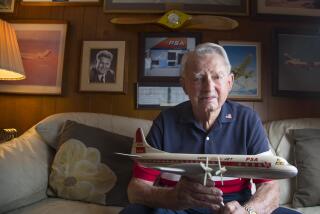Flying Tigers Aid Soviet Armenia
- Share via
When Jean Claude Demirdjian, a Flying Tigers pilot based in Los Angeles, was on a September vacation touring Soviet Armenia, he traveled down a road from Tbilisi to the Armenian capital of Yerevan, taking photographs of the people and buildings of the small towns on the bus route.
“During the five-hour drive, the bus stopped in little towns along the way,” said Demirdjian, a Parisian-born Armenian who has lived in Los Angeles since 1956. “When people found out that my brother and I were Armenians from Los Angeles, they all came over to talk.” Demirdjian had no idea then that he would return to Soviet Armenia only three months later, this time ferrying desperately needed medical supplies after the Dec. 7 earthquake that devastated the same region he had visited.
After the earthquake, Demirdjian and three other Los Angeles Flying Tiger pilots volunteered to take one of the air cargo company’s 747s to Yerevan loaded with 75,000 pounds of medical supplies, including seven dialysis machines and a MASH unit (a mobile Army surgical hospital operating room).
Along the way, with stops in Portland and Seattle, New York and Frankfurt, the Los Angeles crew picked up three more Flying Tiger pilots, 14 flight attendants, 2 mechanics and 53 medical personnel, doctors, nurses and paramedics, and a team of search-and-rescue workers with their tracking dogs. All the personnel for the flight were volunteers; the supplies donated by various organizations, here and abroad.
Flying Tigers, Demirdjian explained, supplied the plane for them to use, plus the fuel. “A 747 uses about $12,000 of fuel an hour, so that amounts to about $350,000 in just fuel,” he said.
“Just landing was no easy thing to do,” Demirdjian said. “As we got close to Soviet Georgia, there was a lot of chatter (on the radio), and there were more airplanes out there than at Chicago’s O’Hare.”
Once on the ground, it took the Flying Tiger group, assisted by Armenian and Russian workers and Soviet pilots, about four hours to unload their cargo and get ready to leave.
“We were taking off at night, and the official airport navigator came on board to tell us the procedure,” Demirdjian said. “He spoke Armenian, so I was able to translate since I speak Armenian. But he wanted to be very sure that we understood the procedure--that when you take off you have to make an immediate 20-degree turn, a minimum of 20 degrees. To the north of the airport, there’s a mountain range of 14,000 feet; to the south, one at 13,000 feet. If you don’t make the turn, you’re going to plaster yourself all over a mountain. He was very very concerned about our safety. . . .”
More to Read
Sign up for Essential California
The most important California stories and recommendations in your inbox every morning.
You may occasionally receive promotional content from the Los Angeles Times.













